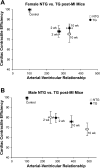Myofilament calcium sensitization delays decompensated hypertrophy differently between the sexes following myocardial infarction
- PMID: 21106909
- PMCID: PMC3043798
- DOI: 10.1152/ajpregu.00321.2010
Myofilament calcium sensitization delays decompensated hypertrophy differently between the sexes following myocardial infarction
Abstract
Contractile dysfunction is common to many forms of cardiovascular disease. Approaches directed at enhancing cardiac contractility at the level of the myofilaments during heart failure (HF) may provide a means to improve overall cardiovascular function. We are interested in gender-based differences in cardiac function and the effect of sarcomere activation agents that increase contractility. Thus, we studied the effect of gender and time on integrated arterial-ventricular function (A-V relationship) following myocardial infarction (MI). In addition, transgenic mice that overexpress the slow skeletal troponin I isoform were used to determine the impact of increased myofilament Ca(2+) sensitivity following MI. Based on pressure-volume (P-V) loop measurements, we used derived parameters of cardiovascular function to reveal the effects of sex, time, and increased myofilament Ca(2+) sensitivity among groups of post-MI mice. Analysis of the A-V relationship revealed that the initial increase was similar between the sexes, but the vascular unloading of the heart served to delay the decompensated stage in females. Conversely, the vascular response at 6 and 10 wk post-MI in males contributed to the continuous decline in cardiovascular function. Increasing the myofilament Ca(2+) sensitivity appeared to provide sufficient contractile support to improve contractile function in both male and female transgenic mice. However, the improved contractile function was more beneficial in males as the concurrent vascular response contributed to a delayed decompensated stage in female transgenic mice post-MI. This study represents a quantitative approach to integrating the vascular-ventricular relationship to provide meaningful and diagnostic value following MI. Consequently, the data provide a basis for understanding how the A-V relationship is coupled between males and females and the enhanced ability of the cardiovascular system to tolerate pathophysiological stresses associated with HF in females.
Figures





Similar articles
-
Sex-related changes in cardiac function following myocardial infarction in mice.Am J Physiol Regul Integr Comp Physiol. 2008 Aug;295(2):R528-34. doi: 10.1152/ajpregu.90342.2008. Epub 2008 Jun 11. Am J Physiol Regul Integr Comp Physiol. 2008. PMID: 18550865 Free PMC article.
-
Early exercise training after myocardial infarction prevents contractile but not electrical remodelling or hypertrophy.Cardiovasc Res. 2010 Apr 1;86(1):72-81. doi: 10.1093/cvr/cvp381. Epub 2009 Dec 9. Cardiovasc Res. 2010. PMID: 20007310
-
Detrimental effect of combined exercise training and eNOS overexpression on cardiac function after myocardial infarction.Am J Physiol Heart Circ Physiol. 2009 May;296(5):H1513-23. doi: 10.1152/ajpheart.00485.2008. Epub 2009 Mar 13. Am J Physiol Heart Circ Physiol. 2009. PMID: 19286956
-
Clinical aspects of left ventricular diastolic function assessed by Doppler echocardiography following acute myocardial infarction.Dan Med Bull. 2001 Nov;48(4):199-210. Dan Med Bull. 2001. PMID: 11767125 Review.
-
Testosterone deficiency prevents left ventricular contractility dysfunction after myocardial infarction.Mol Cell Endocrinol. 2018 Jan 15;460:14-23. doi: 10.1016/j.mce.2017.06.011. Epub 2017 Jun 9. Mol Cell Endocrinol. 2018. PMID: 28606867 Review.
Cited by
-
Deregulated Ca2+ cycling underlies the development of arrhythmia and heart disease due to mutant obscurin.Sci Adv. 2017 Jun 7;3(6):e1603081. doi: 10.1126/sciadv.1603081. eCollection 2017 Jun. Sci Adv. 2017. PMID: 28630914 Free PMC article.
-
Beneficial effects of SR33805 in failing myocardium.Cardiovasc Res. 2011 Aug 1;91(3):412-9. doi: 10.1093/cvr/cvr096. Epub 2011 Apr 4. Cardiovasc Res. 2011. PMID: 21467075 Free PMC article.
References
-
- Antoniades C, Antonopouls AS, Tousoulis D, Bakogiannis C, Stefanadi E, Stefanadis C. Relationship between the pharmacokinetics of levosimendan and its effects on cardiovascular system. Curr Drug Metab 10: 95–103, 2009 - PubMed
-
- Arteaga GM, Warren CM, Milutinovic S, Martin AF, Solaro RJ. Specific enhancement of sarcomeric response to Ca2+ protects murine myocardium against ischemia/reperfusion dysfunction. Am J Physiol Heart Circ Physiol 289: H2183–H2192, 2005 - PubMed
-
- Bátkai S, Rajesh M, Mukhopadhyay P, Haskó G, Liaudet L, Cravatt BF, Csiszár A, Ungvári Z, Pacher P. Decreased age-related cardiac dysfunction, myocardial nitrative stress, inflammatory gene expression, and apoptosis in mice lacking fatty acid amide hydrolase. Am J Physiol Heart Circ Physiol 293: H909–H918, 2007 - PMC - PubMed
-
- Belin RJ, Sumandea MP, Kobayashi T, Walker LA, Rundell VL, Urboniene D, Yuzhakova M, Ruch SH, Geenen DL, Solaro RJ, de Tombe PP. Left ventricular myofilament dysfunction in rat experimental hypertrophy and congestive heart failure. Am J Physiol Heart Circ Physiol 291: H2344–H2353, 2006 - PubMed
-
- Burkhoff D, Mirsky I, Suga H. Assessment of systolic and diastolic ventricular properties via pressure-volume analysis: a guide for clinical, translational, and basic researchers. Am J Physiol Heart Circ Physiol 289: H501–H512, 2005 - PubMed
Publication types
MeSH terms
Substances
Grants and funding
LinkOut - more resources
Full Text Sources
Medical
Molecular Biology Databases
Research Materials
Miscellaneous

